An Information Theory Inspired Real-Time Self-Adaptive Scheduling for Production-Logistics Resources: Framework, Principle, and Implementation
Abstract
:1. Introduction
2. Related Work
3. Framework of Real-Time Self-Adaptive Scheduling
3.1. Characteristics and Description of the Problem
- Scheduling objects. Most of the existing scheduling methods mainly focus on production resources, while the scheduling of workshop logistics resources is simplified. For example, the research on production usually only considers the scheduling of machines and regards logistics processing as a boundary condition [19]. The logistics processing systems pay more attention to issues such as route optimization [27]. However, in the environment of Industry 4.0, more and more intelligent manufacturing equipment such as smart machines and smart vehicles will be used in the job-shop. Scheduling resources include not only production equipment, but also logistics equipment, such as AGVs. The Production-Logistics Resources in the real-time production process influence and restrict each other. The construction of Production-Logistics Resources dynamic cooperation mode is the basis of Production-Logistics Resources adaptive collaboration;
- Execution. Due to the existence of fuzzy factors of the operation time, the essence of each task assignment is based on the prediction of the service capacity of the current Production-Logistics Resources. Therefore, the results of each task execution cannot be accurately predicted.
- As time goes on, random jobs arrive in the job-shop. Moreover, the distribution of job arrival process follows the Poisson distribution;
- The operation time of Production-Logistics Resources obeys the fuzzy triangular distribution , where is the estimated operation time of Production-Logistics Resources. and denote the upper and lower bounds of the fuzzy intervals;
- Since the communication cost is not considered, the waiting energy consumption of AGVs is zero;
- The loading and unloading time of AGVs is regarded as logistics time;
- Machines and AGVs only process one Work In Progress (WIP) at a time.
3.2. The Framework of Real-Time Self-Adaption Scheduling
4. Real-Time Reaction Scheduling Strategy
4.1. Capability Model of Production-Logistics Resources
4.2. Scheduling Trigger Mechanism Based on Real-Time Tasks
4.3. Real-Time Reaction Scheduling Algorithm
4.3.1. Objective Functions of Smart Job-Shop
4.3.2. Objective Functions of Real-Time Self-Adaption Collaboration
- (1)
- In order to strengthen the dynamic collaboration among resources, such as production resources and logistic resources, participate in the task allocation and execution in the form of groups:
- (2)
- The service capacity of each group includes service time and energy consumption for task :where, denotes time cost of picking up WIP. denotes time cost of delivering the WIP to the appropriate location. denotes the processing time. denotes time cost of Production- Logistics Resources collaboration, such as the waiting time of pick-up and processing. denotes energy consumption of picking up WIP. denotes energy consumption of delivering the WIP to the appropriate location. denotes the energy consumption of processing time. denotes the energy consumption of Production-Logistics Resources collaboration, such as the idle power consumption.
- (3)
- In order to estimate the urgency of , we use the method of paper [29], which is shown in Equation (9), where is the estimation time of remaining and is the remaining time of . Details can be obtained from our previous work in [29].In order to achieve the goal of adaptive scheduling, task tardiness is used to balance operation time and energy consumption index. Equations (10)–(12) are the implementation processes:In order to avoid the overflow of the definition domain in logarithm operation, Equation (10) guarantees the ranges from 0 to 1. Equation (11) denotes adaptive weight based on information entropy of task . Equation (12) denotes the adaptive dynamic collaborative evaluation function of Production-Logistics Resources.
4.3.3. The Information Model of the Real-Time System and Mathematics Mechanism Analysis
- (1)
- The tasks in the scheduling pool can be described as at time t, where , ;
- (2)
- All tasks in the task pool are attainable, which is ;
- (3)
- At present, the relevant information value of service matching calculation is only ideal. The system will schedule production according to the assigned tasks and will not change.
4.3.4. Real-Time Production-Logistics Resources Adaptive Collaboration Strategy
5. Case Study
5.1. Case Description
- The simulation period is 1800 s. That is, 15 jobs arrive at random within 30 min, (i.e., the arrival time of the jobs obeys Poisson distribution , );
- The interval between the arrival time and the due date of jobs is 2000 s;
- In order to analyze the relationship between information utility and disturbance degree, three kinds of disturbance are set up in this paper: No disturbance , slight disturbance , and high disturbance . In this form and .
5.2. Results of Experiments
5.3. Discussion
6. Conclusions and Future Work
Author Contributions
Funding
Acknowledgments
Conflicts of Interest
References
- Jessica Ulmer, A.; Sebastian Braun, A.; Chi Tsun Cheng, B.; Steve Dowey, B.; Jrg Wollert, A. Human-Centered Gamification Framework for Manufacturing Systems. Procedia CIRP 2020, 93, 670–675. [Google Scholar] [CrossRef]
- Hofmann, E.; Rüsch, M. Industry 4.0 and the current status as well as future prospects on logistics. Comput. Ind. 2017, 89, 23–34. [Google Scholar] [CrossRef]
- Kourtis, G.; Kavakli, E.; Sakellariou, R. A Rule-Based Approach Founded on Description Logics for Industry 4.0 Smart Factories. IEEE Trans. Ind. Inform. 2019, 15, 4888–4899. [Google Scholar] [CrossRef] [Green Version]
- Burdett, R.L.; Kozan, E. The assignment of individual renewable resources in scheduling. Asia-Pac. J. Oper. Res. 2004, 21, 355–377. [Google Scholar] [CrossRef] [Green Version]
- Moshiri, M.; Charles, A.; Elkaseer, A.; Scholz, S.; Mohanty, S.; Tosello, G. An Industry 4.0 framework for tooling production using metal additive manufacturing-based first-time-right smart manufacturing system. Procedia CIRP 2020, 93, 32–37. [Google Scholar] [CrossRef]
- Guo, D.; Zhong, R.Y.; Ling, S.; Rong, Y.; Huang, G.Q. A roadmap for Assembly 4.0: Self-configuration of fixed-position assembly islands under Graduation Intelligent Manufacturing System. Int. J. Prod. Res. 2020, 58, 1–16. [Google Scholar] [CrossRef]
- Li, G.; Yang, S.; Xu, Z.; Wang, J.; Ren, Z.; Li, G. Resource allocation methodology based on object-oriented discrete event simulation: A production logistics system case study. CIRP J. Manuf. Sci. Technol. 2020, 57, 351–356. [Google Scholar] [CrossRef]
- Spratt, B.; Kozan, E. A real-time reactive framework for the surgical case sequencing problem. Flex. Serv. Manuf. J. 2019, 1–29. [Google Scholar] [CrossRef] [Green Version]
- Zhu, H.; Chen, M.; Zhang, Z.; Tang, D. An Adaptive Real-Time Scheduling Method for Flexible Job Shop Scheduling Problem With Combined Processing Constraint. IEEE Access 2019, 7, 125113–125121. [Google Scholar] [CrossRef]
- Zhang, L.; Gao, L.; Li, X. A hybrid genetic algorithm and tabu search for a multi-objective dynamic job shop scheduling problem. Int. J. Prod. Res. 2013, 51, 3516–3531. [Google Scholar] [CrossRef]
- Wang, Z.; Zhang, J.; Yang, S. An improved particle swarm optimization algorithm for dynamic job shop scheduling problems with random job arrivals. Swarm Evol. Comput. 2019, 51, 100594. [Google Scholar] [CrossRef]
- Kundakci, N.; Kulak, O. Hybrid genetic algorithms for minimizing makespan in dynamic job shop scheduling problem. Comput. Ind. Eng. 2016, 96, 31–51. [Google Scholar] [CrossRef]
- Luo, J.; Baz, D.E.; Xue, R.; Hu, J. Solving the dynamic energy aware job shop scheduling problem with the heterogeneous parallel genetic algorithm. Future Gener. Comput. Syst. 2020, 108, 119–134. [Google Scholar] [CrossRef]
- Lei, D. Co-evolutionary genetic algorithm for fuzzy flexible job shop scheduling. Appl. Soft Comput. J. 2012, 12, 2237–2245. [Google Scholar] [CrossRef]
- Sun, L.; Lin, L.; Gen, M.; Li, H. A Hybrid Cooperative Coevolution Algorithm for Fuzzy Flexible Job Shop Scheduling. IEEE Trans. Fuzzy Syst. 2019, 27, 1008–1022. [Google Scholar] [CrossRef]
- Lin, J.; Zhu, L.; Wang, Z.J. A hybrid multi-verse optimization for the fuzzy flexible job-shop scheduling problem. Comput. Ind. Eng. 2018, 127, 1089–1100. [Google Scholar] [CrossRef]
- Maiwald, M. Integrated and Networked Systems and Processes—A Perspective for Digital Transformation in Thermal Process Engineering. Chem. Eng. 2020, 4, 15. [Google Scholar] [CrossRef] [Green Version]
- Jong, K.C.; Kim, Y.D. A real-time scheduling mechanism for a flexible manufacturing system: Using simulation and dispatching rules. Int. J. Prod. Res. 1998, 36, 2609–2626. [Google Scholar] [CrossRef]
- Yang, M.; Zhu, H.; Guo, K. Research on manufacturing service combination optimization based on neural network and multi-attribute decision making. Neural Comput. Appl. 2019, 32, 1691–1700. [Google Scholar] [CrossRef]
- Cheng, Y.; Bi, L.; Tao, F.; Ji, P. Hypernetwork-based manufacturing service scheduling for distributed and collaborative manufacturing operations towards smart manufacturing. J. Intell. Manuf. 2018, 31, 1707–1720. [Google Scholar] [CrossRef]
- Ding, K.; Zhang, X.; Chan, F.T.S.; Chan, C.Y.; Wang, C. Training a Hidden Markov Model-Based Knowledge Model for Autonomous Manufacturing Resources Allocation in Smart Shop Floors. IEEE Access 2019, 7, 47366–47378. [Google Scholar] [CrossRef]
- Burdett, R.L.; Corry, P.; Eustace, C.; Smith, S. Scheduling Pre-emptible Tasks with Flexible Resourcing Options and Auxiliary Resource Requirements. Comput. Ind. Eng. 2020, 106939. [Google Scholar] [CrossRef]
- Qu, T.; Pan, Y.; Liu, X.; Kang, K.; Li, C.; Thurer, M.; Huang, G.Q. Internet of Things-based real-time production logistics synchronization mechanism and method toward customer order dynamics. Trans. Inst. Meas. Control 2017, 39, 429–445. [Google Scholar] [CrossRef]
- Guo, Z.; Zhang, Y.; Zhao, X.; Song, X. A Timed Colored Petri Net Simulation-Based Self-Adaptive Collaboration Method for Production-Logistics Systems. Appl. Sci. 2017, 7, 235. [Google Scholar] [CrossRef] [Green Version]
- Zhang, Y.; Guo, Z.; Lv, J.; Liu, Y. A Framework for Smart Production-Logistics Systems Based on CPS and Industrial IoT. IEEE Trans. Ind. Inform. 2018, 14, 4019–4032. [Google Scholar] [CrossRef] [Green Version]
- Burdett, R.L.; Kozan, E. Evolutionary algorithms for resource constrained non-serial mixed flow shops. Int. J. Comput. Intell. Appl. 2003, 3, 411–435. [Google Scholar] [CrossRef] [Green Version]
- Welgama, P.S.; Gibson, P.R. A hybrid knowledge based/optimization system for automated selection of materials handling system. Comput. Ind. Eng. 1995, 28, 205–217. [Google Scholar] [CrossRef]
- Vela, C.R.; Afsar, S.; Palacios, J.J.; González-Rodríguez, I.; Puente, J. Evolutionary tabu search for flexible due-date satisfaction in fuzzy job shop scheduling. Comput. Oper. Res. 2020, 119, 104931. [Google Scholar] [CrossRef]
- Yang, W.; Li, W.; Cao, Y.; Lun, Y.; He, L. Real-Time Production and Logistics Self-Adaption Scheduling Based on Information Entropy Theory. Sensors 2020, 20, 4507. [Google Scholar] [CrossRef]
- Wang, J.; Zhang, Y.; Liu, Y.; Wu, N. Multiagent and Bargaining-Game-Based Real-Time Scheduling for Internet of Things-Enabled Flexible Job Shop. IEEE Internet Things J. 2019, 6, 2518–2531. [Google Scholar] [CrossRef] [Green Version]
- Tuffaha, H.W.; Strong, M.; Gordon, L.G.; Scuffham, P.A. Efficient Value of Information Calculation Using a Nonparametric Regression Approach: An Applied Perspective. Value Health 2016, 19, 505–509. [Google Scholar] [CrossRef] [Green Version]
- Tarannom, P.; Samaneh, B.; Ali, M. An Entropy Based Bayesian Network Framework for System Health Monitoring. Entropy 2018, 20, 416. [Google Scholar]
- Burdett, R.L.; Kozan, E. Sequencing and scheduling in flowshops with task redistribution. J. Oper. Res. Soc. 2001, 52, 1379–1389. [Google Scholar] [CrossRef]
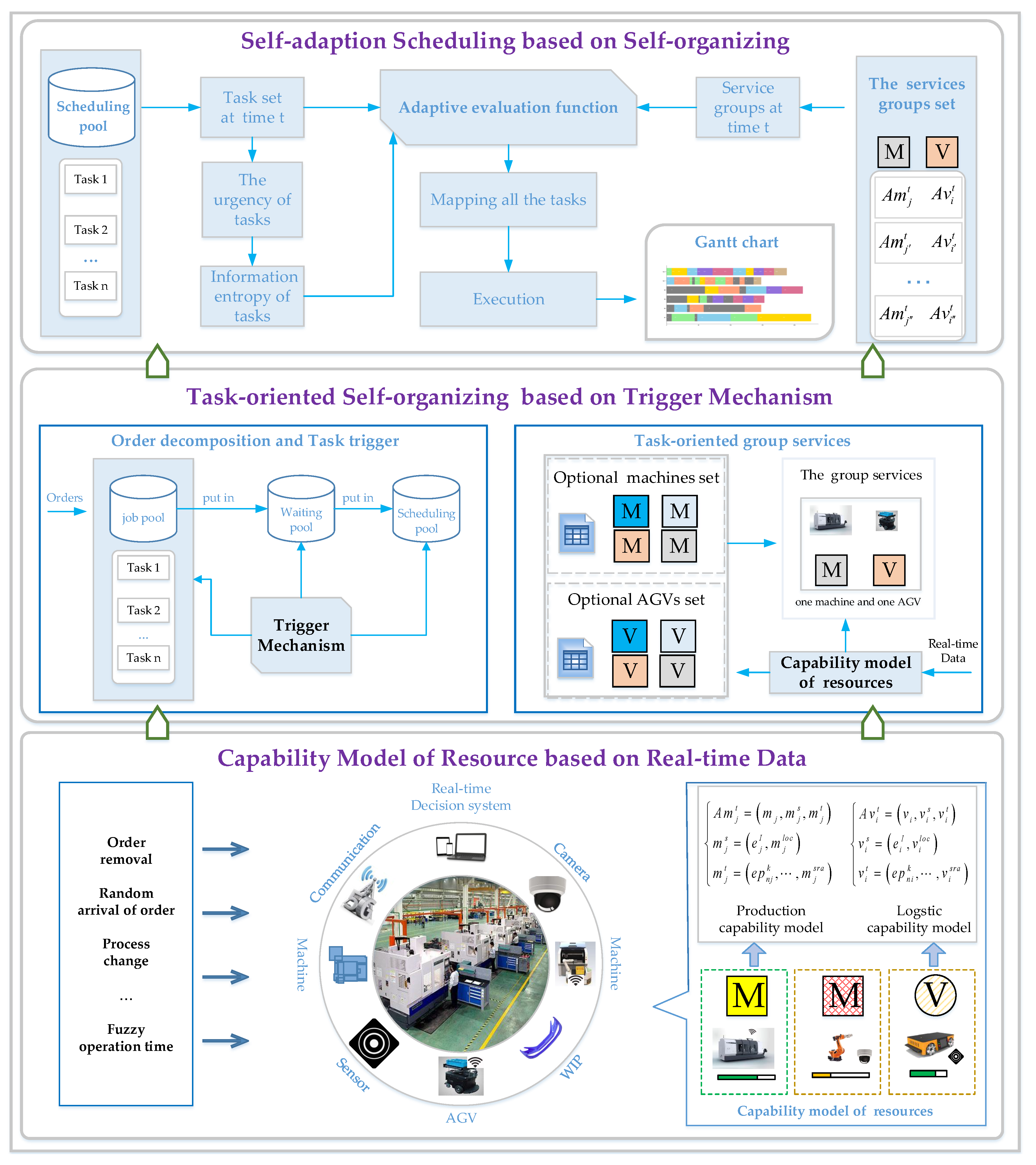
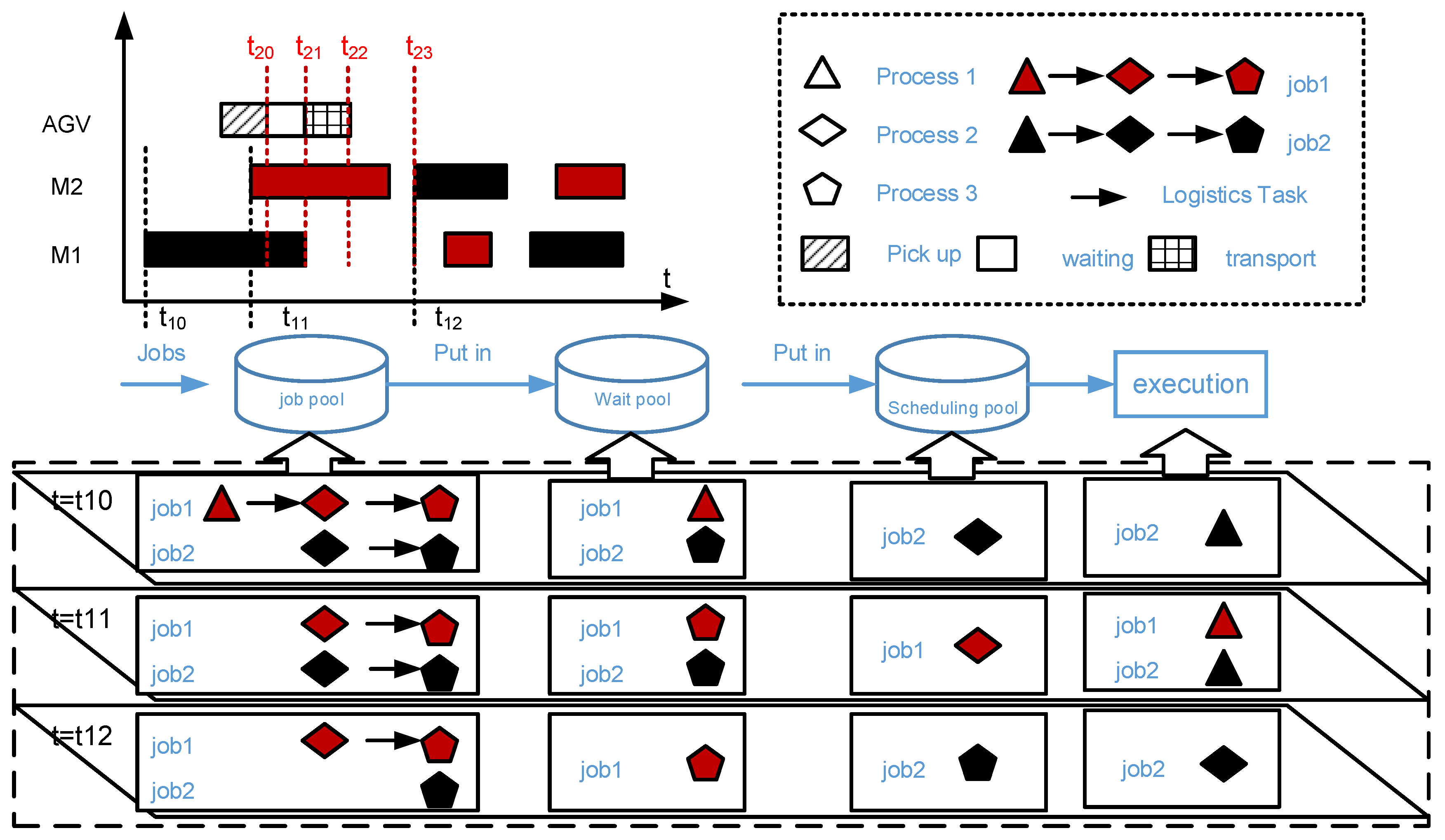
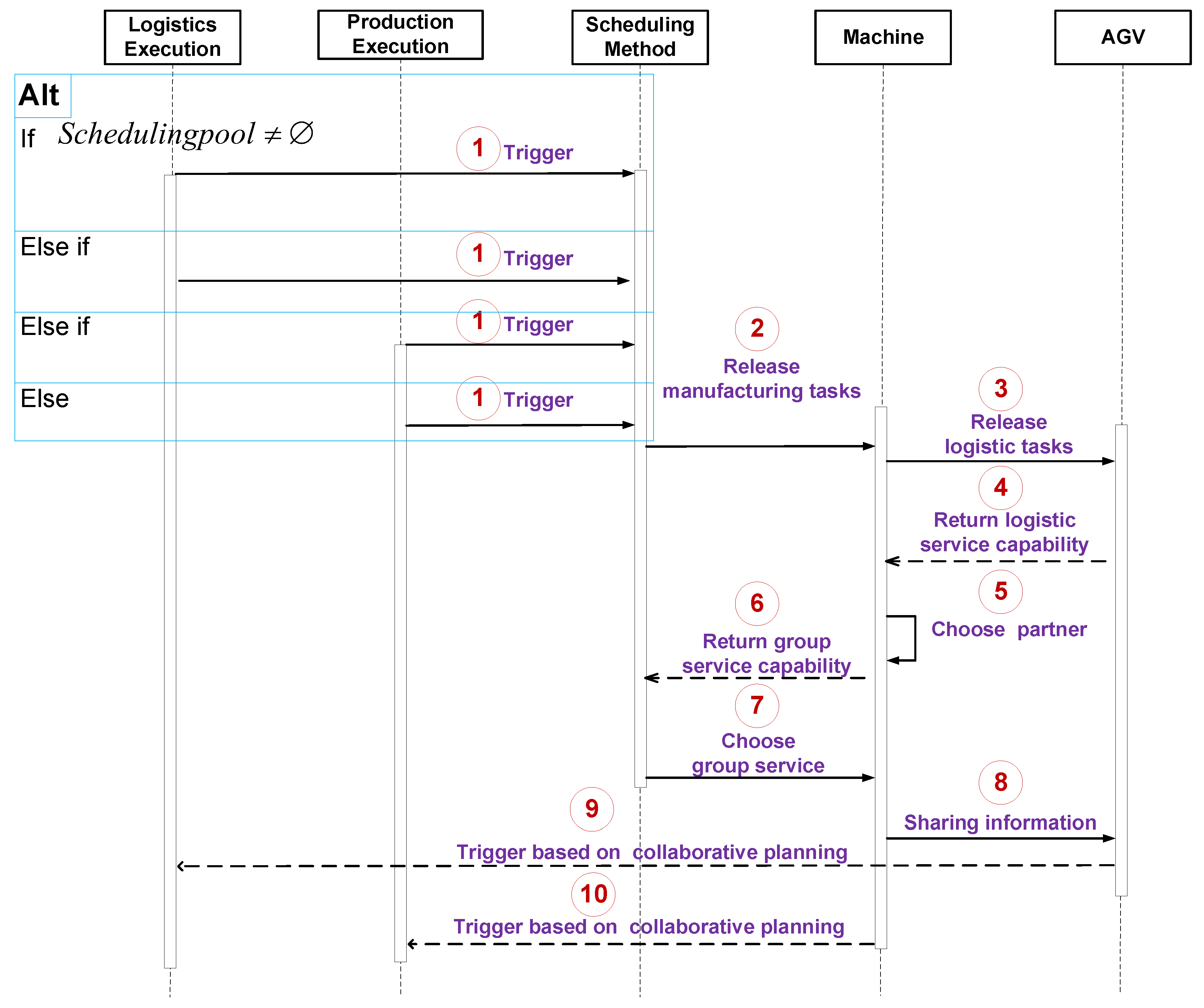
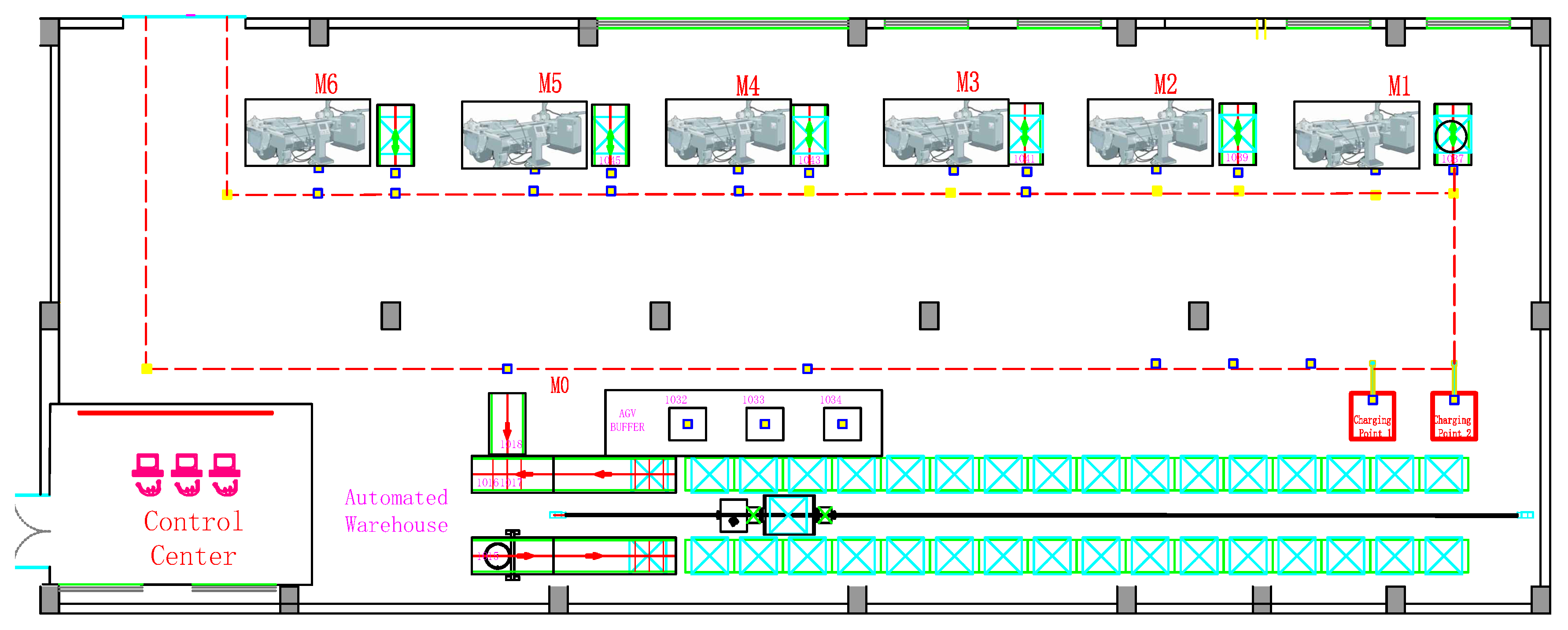
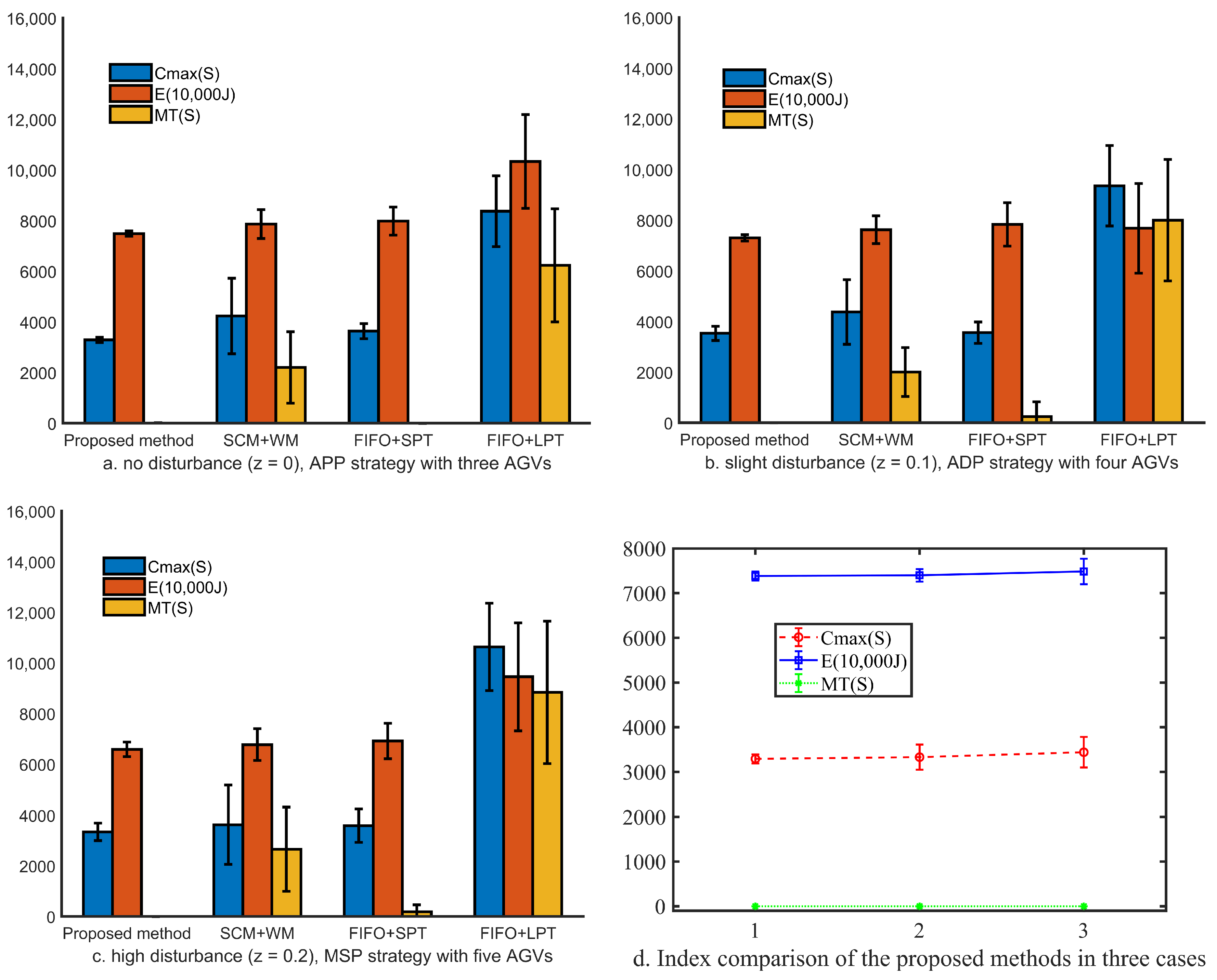
| Symbol | Definition |
|---|---|
| n-th job | |
| k-th operation of | |
| The equipment number of machine j | |
| The equipment number of AGV (Automated Guided Vehicle) i | |
| The capability model of | |
| The capability model of | |
| The static properties of | |
| The real-time properties of | |
| Type of service that a machine can provide | |
| The static properties of | |
| The real-time properties of | |
| The set of service groups at time t | |
| The service group y, | |
| The service time of | |
| The energy consumption of | |
| Optional machine set | |
| Optional AGV set | |
| Completion time of | |
| Due date for | |
| The arrival time of | |
| Tardiness of |
| Distance [m] | |||||||
|---|---|---|---|---|---|---|---|
| 0 | 40 | 46 | 52 | 60 | 66 | 66 | |
| 40 | 0 | 6 | 12 | 16 | 24 | 33 | |
| 46 | 6 | 0 | 6 | 18 | 18 | 27 | |
| 52 | 12 | 6 | 0 | 6 | 12 | 21 | |
| 60 | 18 | 12 | 6 | 0 | 3 | 15 | |
| 66 | 24 | 18 | 12 | 6 | 0 | 9 | |
| 75 | 33 | 27 | 21 | 15 | 9 | 0 |
| Time Power [KW] | ||||||
|---|---|---|---|---|---|---|
| job | 180∖3.74 | 190∖3.11 | 170∖4.38 | 180∖4.24 | 190∖3.41 | 200∖4.5 |
| 170∖4.38 | 190∖4.11 | 170∖4.48 | 170∖4.59 | 180∖4.24 | 200∖3.95 | |
| 360∖4.06 | 340∖3.18 | 370∖3.70 | 360∖4.08 | 350∖5.82 | 360∖4.08 | |
| 230∖4.18 | 240∖4.13 | 250∖3.20 | 230∖4.19 | 240∖4.09 | 200∖5.01 | |
| 220∖5.40 | 220∖5.39 | 240∖4.17 | 230∖5.28 | 240∖4.68 | 260∖4.57 |
| Power [KW] | 0.98 | 1.23 | 1.48 | 1.06 | 1.06 | 1.16 |
| Power [KW] | 1 |
| Speed [m/s] | 0.5 |
| NA | APP Strategy with z = 0 | APP Strategy with z = 0.1 | APP Strategy with z = 0.2 | ||||||
|---|---|---|---|---|---|---|---|---|---|
| 1 | 3798 | 79,924,197 | 1299 | 3974 | 79,064,846 | 1497 | 5939 | 82,408,311 | 3968 |
| 2 | 3405 | 75,691,990 | 0 | 3510 | 74,218,272 | 0 | 3880 | 77,725,213 | 467 |
| 3 | 3292 | 72,897,863 | 0 | 3503 | 76,812,363 | 1 | 3713 | 76,131,173 | 193 |
| 4 | 3391 | 74,436,105 | 0 | 3667 | 75,481,459 | 8 | 3825 | 75,668,381 | 221 |
| 5 | 3365 | 74,412,437 | 0 | 3746 | 74,057,854 | 24 | 3837 | 77,256,997 | 314 |
| NA | PW Strategy with z = 0 | PW Strategy withz = 0.1 | PW Strategy with z = 0.2 | ||||||
| 1 | 3822 | 79,330,556 | 1253 | 6089 | 84,452,674 | 2396 | 6218 | 84,428,615 | 1843 |
| 2 | 3792 | 74,608,693 | 123 | 3446 | 76,928,827 | 9 | 3893 | 78,549,737 | 22 |
| 3 | 3672 | 72,865,634 | 0 | 3327 | 75,986,267 | 0 | 3809 | 78,069,589 | 0 |
| 4 | 3575 | 73,633,627 | 17 | 3271 | 74,990,092 | 0 | 3837 | 77,075,180 | 24 |
| 5 | 3449 | 73,435,680 | 2 | 3244 | 74,585,985 | 0 | 3765 | 76,519,139 | 0 |
| NA | ADP Strategy with z = 0 | ADP Strategy with z = 0.1 | ADP Strategy with z = 0.2 | ||||||
| 1 | 5782 | 81,177,935 | 4808 | 3898 | 78,571,162 | 1624 | 3733 | 79,126,854 | 1479 |
| 2 | 3518 | 76,528,125 | 0 | 3535 | 76,166,753 | 0 | 3655 | 77,026,135 | 173 |
| 3 | 3334 | 68,141,735 | 59 | 3404 | 74,811,448 | 0 | 3766 | 78,408,417 | 354 |
| 4 | 3450 | 69,135,093 | 0 | 3331 | 74,045,920 | 0 | 3845 | 76,968,627 | 0 |
| 5 | 3399 | 67,960,194 | 44 | 3415 | 74,651,475 | 0 | 3886 | 76,126,530 | 0 |
| NA | MSP Strategy with z = 0 | MSP Strategy with z = 0.1 | MSP Strategy with z = 0.2 | ||||||
| 1 | 6147 | 84,598,977 | 3891 | 5987 | 84,610,784 | 2405 | 3998 | 78,673,637 | 2663 |
| 2 | 3749 | 76,817,096 | 517 | 3717 | 75,762,852 | 603 | 3575 | 77,627,778 | 104 |
| 3 | 3620 | 75,826,995 | 325 | 3551 | 76,028,675 | 219 | 3538 | 77,907,632 | 0 |
| 4 | 3658 | 68,436,910 | 135 | 3531 | 76,005,146 | 221 | 3476 | 76,699,788 | 0 |
| 5 | 3678 | 69,111,867 | 35 | 3529 | 75,609,530 | 198 | 3441 | 74,860,718 | 0 |
Publisher’s Note: MDPI stays neutral with regard to jurisdictional claims in published maps and institutional affiliations. |
© 2020 by the authors. Licensee MDPI, Basel, Switzerland. This article is an open access article distributed under the terms and conditions of the Creative Commons Attribution (CC BY) license (http://creativecommons.org/licenses/by/4.0/).
Share and Cite
Yang, W.; Li, W.; Cao, Y.; Luo, Y.; He, L. An Information Theory Inspired Real-Time Self-Adaptive Scheduling for Production-Logistics Resources: Framework, Principle, and Implementation. Sensors 2020, 20, 7007. https://doi.org/10.3390/s20247007
Yang W, Li W, Cao Y, Luo Y, He L. An Information Theory Inspired Real-Time Self-Adaptive Scheduling for Production-Logistics Resources: Framework, Principle, and Implementation. Sensors. 2020; 20(24):7007. https://doi.org/10.3390/s20247007
Chicago/Turabian StyleYang, Wenchao, Wenfeng Li, Yulian Cao, Yun Luo, and Lijun He. 2020. "An Information Theory Inspired Real-Time Self-Adaptive Scheduling for Production-Logistics Resources: Framework, Principle, and Implementation" Sensors 20, no. 24: 7007. https://doi.org/10.3390/s20247007
APA StyleYang, W., Li, W., Cao, Y., Luo, Y., & He, L. (2020). An Information Theory Inspired Real-Time Self-Adaptive Scheduling for Production-Logistics Resources: Framework, Principle, and Implementation. Sensors, 20(24), 7007. https://doi.org/10.3390/s20247007





